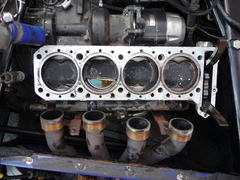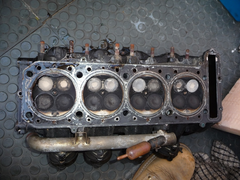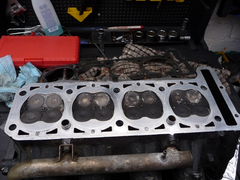
Help with diagnosis please?
Guinness - 19/7/09 at 10:08 AM
Right, following my earlier thread, I drained down the coolant and oil, stripped back the carbs / zorst and set about removing the head.
Got the cams out and the bolts out (does anyone know if the head bolts on a ZZR are stretch, or can they be re-used??)
Anyway, when I lifted the head off, this is what I saw:-


Wet Cylinder
My initial guess was HGF. However now I'm not so sure. There were no visible tracks across the head / block between the waterways and the
cylinder. The gasket is a steel gasket with a sort of thin black paint on either side. Again I can't find any clear evidence of tracks, but as
about 30% of the "paint" stayed on the block and the rest on the gasket, it's pretty hard to diagnose.
Bear in mind that the engine fired up and ran OK the day before I stripped it down. But that every time I started it after it had stood, I got a fair
bit of black sooty water out of the exhaust.
I'm thinking I need to get the head pressure tested before commiting any more time / money into refurbing it.
(IDIOT WARNING) How do they pressure test it?? Do I get that done before I remove the valves / plugs? etc
Can they skim it with the valves in situ?
Cheers
Mike
jpindy3 - 19/7/09 at 10:18 AM
you need to put the head back on and the pressure gauge gos in the spark plug holes,thinking of it now you carnt i dont think unless you get a new
head gasket and bolts if you need them put it all back then pressure test,is it worth it,just refurb the engine
[Edited on 19/7/09 by jpindy3]
huskychaser - 19/7/09 at 10:22 AM
Hi, do you have a picture of the head, --block does not look very good around waterways, Dave.
huskychaser - 19/7/09 at 10:24 AM
Hi, you can get the head crack tested on its own without re fitting.
Guinness - 19/7/09 at 10:27 AM
With the gasket still in situ.


Cylinder Head
I've done a compression test and it was very low, but pretty even across all four cylinders.
When they crack / pressure test the head do I need to leave the valves in or should they be removed first?
Mike
[Edited on 19/7/09 by Guinness]
huskychaser - 19/7/09 at 10:32 AM
Hi, i always strip head completely first, what readings did you get from compression test?.
MakeEverything - 19/7/09 at 10:35 AM
Sounds to me like condensation in the exhaust if you only get this after it has been standing?
Guinness - 19/7/09 at 10:38 AM
Cylinder head cleaned up a bit with toothbrush / wifes nail varnish remover!


cleaned head
Compression test as follows:-
Cyl 1 = Actual 115psi = Minimum 128psi Max 196psi
Cyl 2 = Actual 105psi = Minimum 128psi Max 196psi
Cyl 3 = Actual 105psi = Minimum 128psi Max 196psi
Cyl 4 = Actual 115psi = Minimum 128psi Max 196psi
Mike
iank - 19/7/09 at 10:45 AM
I think you have to strip the valves off first (keep them in order as you're supposed to put them back in the same place are reassembly (shove
them through a bit of corrugated cardboard in their correct positions is the easy way).
Once they are off and the head cleaned of the carbon cracks may be visible which will save you money on testing - if you can see a crack then head is
scrap unless the engine is extremely rare and special.
You can get a crack testing spray system from Cromwell's on the Team Valley
http://www.cromwell.co.uk/SOL7320260K
oldtimer - 19/7/09 at 10:52 AM
Going back to your earlier post about dissapearing coolant, did you ever measure the dirty water from the exhaust to see if was a similar quantity to
the drop in your system? Cylinder pressures all similar and low surely points to normal engine wear. Without any expert knowledge I would be thinking
have the head and block tested for cracks and true. If OK, hone bores and fit new rings, grind valves and bung it back in. Just my 5 bobs.
Guinness - 19/7/09 at 10:52 AM
Thanks Ian
My engine is VERY special! 
Mike
MikeR - 19/7/09 at 10:56 AM
am I missing something - number 3 piston looks like its got a great big ruddy crack through it.
jpindy3 - 19/7/09 at 10:57 AM
good luck mike,il keep my fingers crossed that all good with the head,
jpindy3 - 19/7/09 at 10:59 AM
quote:
Originally posted by MikeR
am I missing something - number 3 piston looks like its got a great big ruddy crack through it.
its just water and oil
[Edited on 19/7/09 by jpindy3]
rusty nuts - 19/7/09 at 11:13 AM
Looks to me like the problem is water getting into no 3 cylinder , the edge of the piston looks like it has been steam cleaned. Valves do not normally
have to come out for crack testing but MAY have to come out for skimming depending on how far the valve head is below the surface face of the cylinder
head.Have you got a picture of just the head gasket? Does the inlet manifold have any waterways in it ? If so , is it leaking?
mark chandler - 19/7/09 at 11:13 AM
They bolt the head on to a flat plate with 'O' rings to seal the combustion chamber then force water in to see where the leaks are.
Best sent off with valves in place, you could try a bit of locost yourself, stand head on side and fill ports with something thinners, Diesel or
petrol and see if anything comes out the waterways.
Repeat on other side, you may have to leave standing for a few hours.
Crack testing they just splash some special paint on, wipe off and have a looksee with an ultraviolet light. You can get one cheap U/V light from a
pond supplier BTW, the paint is probally the same stuff used for A/C leak tests.
Regards Mark
[Edited on 19/7/09 by mark chandler]
Guinness - 19/7/09 at 11:25 AM
quote:
Originally posted by oldtimer
Going back to your earlier post about dissapearing coolant, did you ever measure the dirty water from the exhaust to see if was a similar quantity to
the drop in your system
No, but the amount lost was about a cylinder full. The amount shot out of the zorst onto the wall / floor of the garage was about half a cylinder
full!
quote:
Originally posted by MikeR
am I missing something - number 3 piston looks like its got a great big ruddy crack through it.
That is coolant, almost equal to the amount of lost between topping it up and leaving it to stand over night!
quote:
Originally posted by rusty nuts
Looks to me like the problem is water getting into no 3 cylinder , the edge of the piston looks like it has been steam cleaned. Valves do not normally
have to come out for crack testing but MAY have to come out for skimming depending on how far the valve head is below the surface face of the cylinder
head.Have you got a picture of just the head gasket? Does the inlet manifold have any waterways in it ? If so , is it leaking?
Inlet manifold doesn't have any waterways in it, just straight ports down into the inlet tract in the head.
About to try Mark's DIY method. Got the head on it's side and just searching about for some suitable liquid to test with.
Cheers
Mike
RAYLEE29 - 19/7/09 at 02:04 PM
hi normally when coolant gets into the cylinder it tends to have a cleaning effect.
the piston top and chamber will look cleaner than the others
yours all look about the same
Mark G - 19/7/09 at 03:44 PM
Has noone noticed that number 1 piston is a different colour (darker) than the other 3. Indicates that no. 1 wasnt running sweet to me. It could be
something as simple as out of balance carbs but also could be a bigger issue... Valves all look ok though...
Guinness - 19/7/09 at 03:56 PM
5 1/2 hours later and there is no trace of the oil from the inlets getting past the valves, nor of coming out the waterways.
Time to drain the oil out and try the exhaust side.
Ignore the change in colouration between cylinder 1 and the rest, it's just had more elbow grease applied to it than the others!
Mike
Guinness - 19/7/09 at 05:11 PM
Well SWIMBO has just diagnosed head gasket failure!
She was taking an interest, and I was explaining the multilayer steel head gasket. She turned it over in her hands and said "why have the layers
delaminated and gone rusty between?"
Doh!
Mike
Mark G - 19/7/09 at 06:36 PM
sometimes a fresh set of eyes is all you need, cyl 1 by any chance?


